The Detergent Chemicals Market is estimated to be valued at USD 76.36 Bn in 2025 and is expected to reach USD 138.78 Bn by 2032, exhibiting a compound annual growth rate (CAGR) of 8.9% from 2025 to 2032.
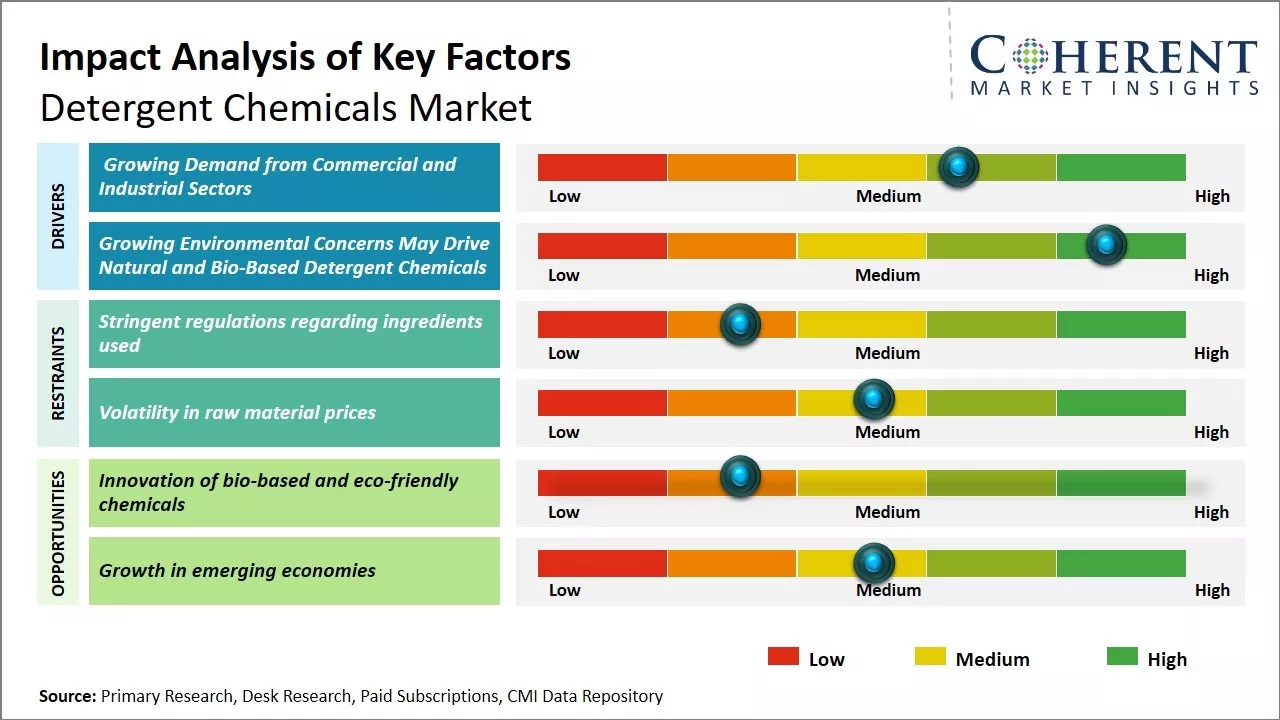
Discover market dynamics shaping the industry: Request sample copy
The market growth is driven by the growing demand for laundry and household cleaners from the residential sector. Wide applications of detergent chemicals in industrial cleaning and textile processing further stimulates the market growth. The detergent chemicals market trends suggest a growing demand for bio-based and green chemicals. Consumers prefer sustainable detergent products with eco-friendly formulations. Manufacturers focus on developing innovative product ranges using natural and plant-based ingredients. Strict regulations regarding environmental safety also propel the demand for green detergent chemicals across major regions.
Growing Demand from Commercial and Industrial Sectors
The demand for detergent chemicals from commercial and industrial sectors is expected to increase significantly over the coming years. With growing industrialization and urbanization worldwide, the needs for cleaning and hygiene products are burgeoning in offices, hospitals, hotels, restaurants, and other public spaces. Proper cleaning is indispensible for maintaining hygienic conditions in commercial establishments to minimize the spread of infections. It is also important from business perspective as clean premises create a positive impression on customers and clients. The food processing and healthcare industries have very stringent hygiene standards to comply with. Thorough cleaning and disinfection of surfaces, equipment and work areas is mandatory in these sectors. Various detergent chemicals specially formulated for industrial and commercial applications such as degreasers, disinfectants, sanitizers etc. are finding increasing usage. Moreover, with increasing health awareness, consumers also expect high hygiene levels from public places like restaurants, malls, public transport etc. This is propelling the commercial establishments to step up their cleaning activities and opt for powerful, multi-purpose detergent products. Growing focus on cleanliness and disinfection in public buildings, transportation systems and workplaces will continue boosting the demand for detergent chemicals from non-residential segments.
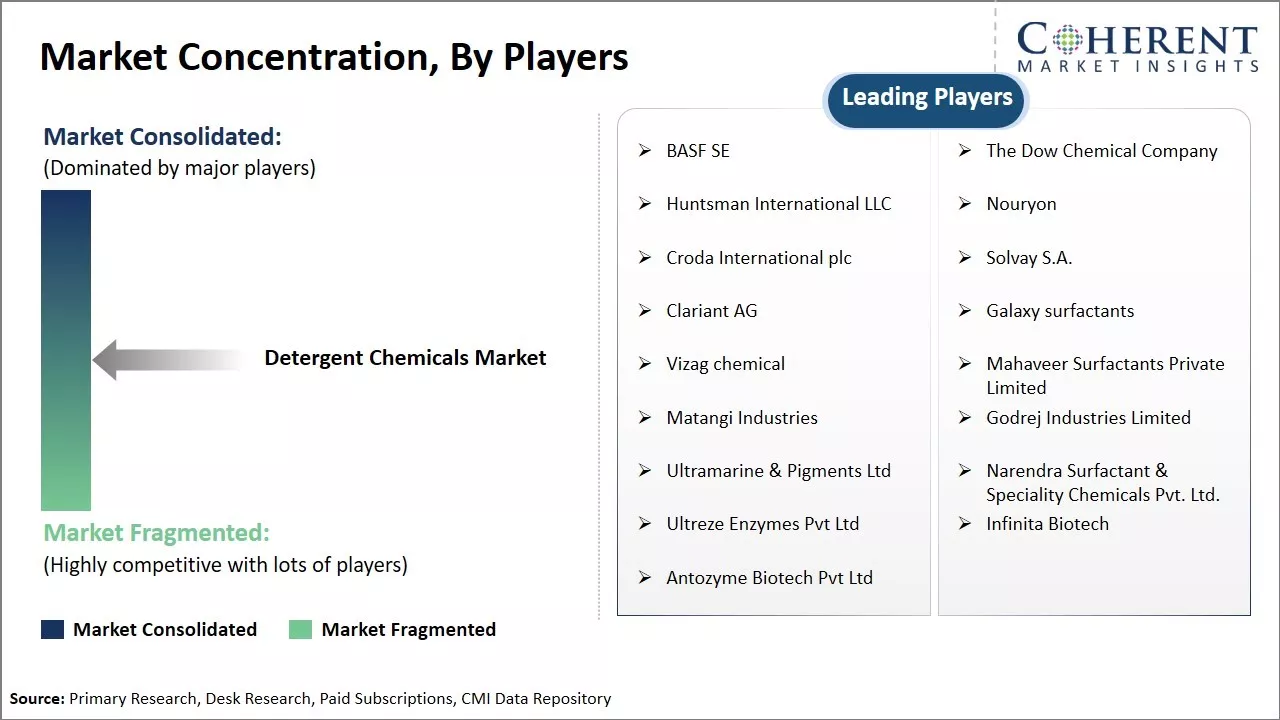
Get actionable strategies to beat competition: Request sample copy
Growing Environmental Concerns May Drive Natural and Bio-Based Detergent ChemicalsGrowing environmental consciousness among people as well as stringent regulations have increased the preference for natural and bio-based alternatives to conventional chemical-based cleaners. There is a widespread perception that plant-derived and eco-friendly products are safer for individuals as well as the surroundings. Consumer demand for natural, biodegradable and sustainable cleaning agents is swiftly growing. As a result, detergent manufacturers are investing in R&D to formulate new 'green' products using plant extracts and other natural components. For example, bio-surfactants obtained from coconut, corn and other crops are being developed as efficient substitutes for synthetic surfactants. Natural citric acid is gaining popularity as a green substitute for phosphates in automatic dishwasher formulations. With rising environmental stewardship, the government and regulatory bodies of many countries are also imposing bans or restrictions on toxic chemicals and promoting sustainable alternatives. This encourages detergent brands to shift their portfolios toward natural and bio-based varieties. The advances in green chemistry and biotechnology has made it feasible to derive high-performance cleaning ingredients.
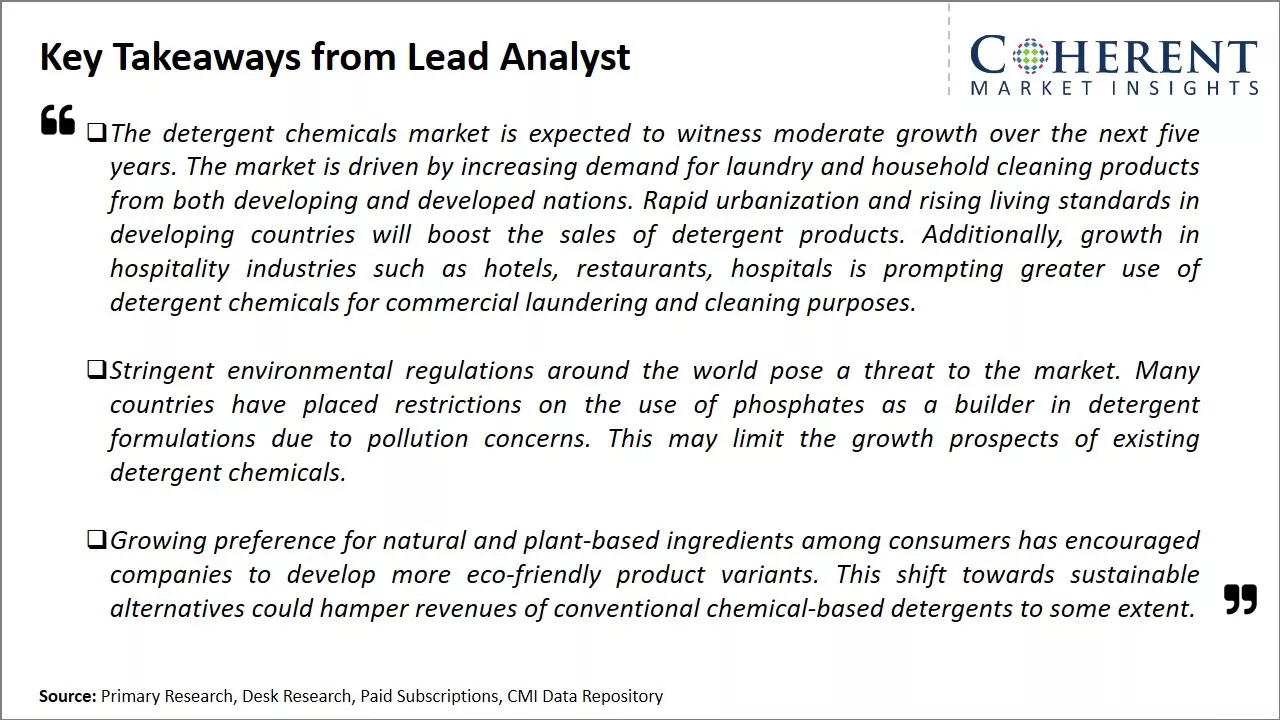
To learn more about this report, Request sample copy
Market Challenges: Stringent regulations regarding ingredients used
Stringent regulations regarding ingredients used is certainly restraining the growth of the detergent chemicals market to some extent. Many governments across the world are imposing strict restrictions on the use of certain chemicals in detergents due to their harmful environmental and health impacts. For instance, phosphates which help in softening water and removing tough stains, are now banned in many countries as they cause eutrophication when they enter lakes and rivers. Phosphates feed algae which grow rapidly using up oxygen in water and killing aquatic life. The U.S. government banned phosphates in detergents nationwide in 2011 to protect water quality. Similarly, regulations have been tightened on other ingredients like chlorine which produces harmful by-products when released into water bodies. The detergent manufacturers are facing challenges in formulating newer products within the framework of these stringent regulations. They have to invest heavily in research and development of alternate ingredients that can deliver similar cleaning results without having negative environmental effects. This has increased the production costs for the manufacturers. According to data by the United Nations Environment Programme, over 30 nations have now imposed complete or partial restrictions on phosphates in laundry detergents due to the widespread water pollution caused. Compliance with these regulations means reformulation of existing products or developing new product formulations. This reformulation process makes the manufacturers less agile in promptly developing innovations, thus somewhat hampering the overall growth potential of this market.
Market Opportunities: Innovation of bio-based and eco-friendly chemicals
The rise in demand for sustainable and environmentally friendly products has motivated detergent manufacturers to incorporate more bio-based and eco-friendly ingredients into their formulations. Consumers are increasingly aware of the impact synthetic chemicals can have on the environment and prefer products with natural or plant-based components. This change in attitude provides a significant opportunity for innovation in the detergent chemicals market. By developing bio-sourced surfactants, builders, enzymes and other functional materials, companies can make their detergents more sustainable without compromising on performance. Some manufacturers have already started utilizing renewable feedstocks such as palm, coconut and sugar beet oils to synthesize fatty acid based chemicals that can effectively clean while degrading more readily than conventional petrochemical detergent ingredients. For example, certain European brands have launched bio-laundry detergents made with over 90% ingredients sourced from plants. The demand for such greener products is expected to grow substantially in the coming years. According to data from the European Consumer Association released in 2021, over 60% of European consumers reported being willing to pay a premium for eco-friendly cleaning products.
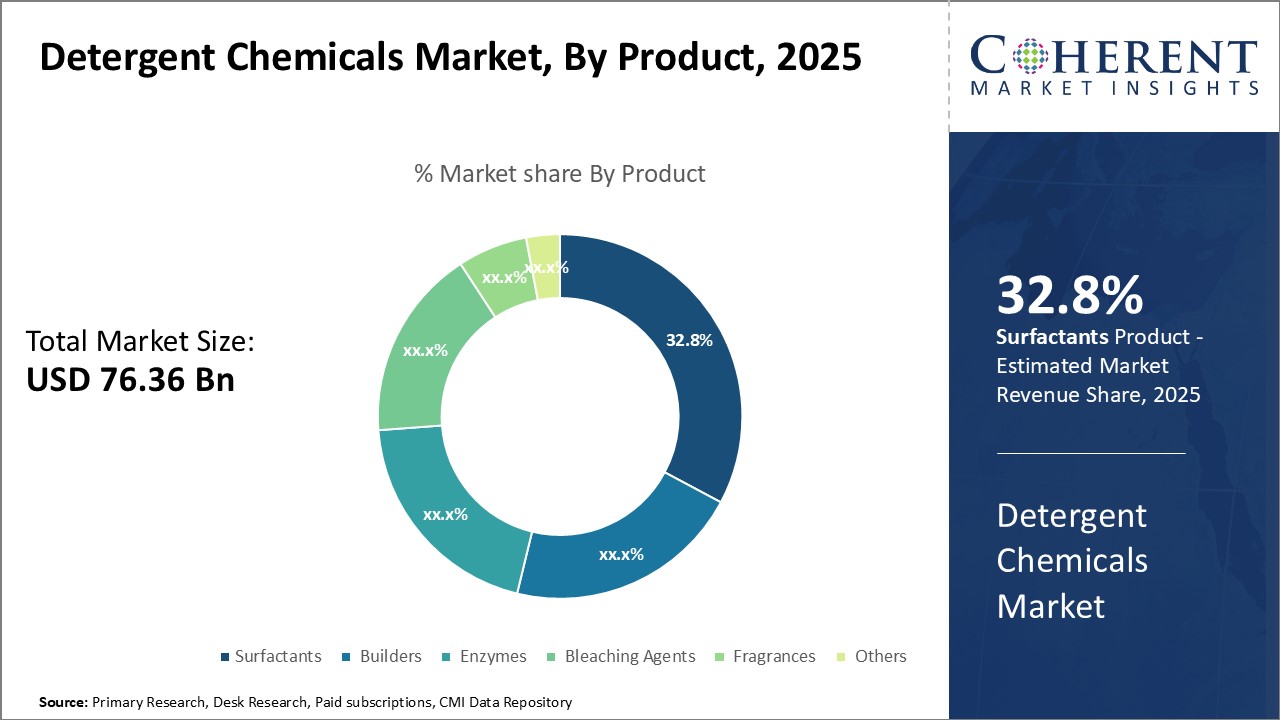
Discover high revenue pocket segments and roadmap to it: Request sample copy
Insights, by Product Type: changing consumer preference drive segment growthIn terms of Product, Surfactants is estimated to hold 32.8% share of the market in 2025. Surfactants dominate the detergent chemicals market based on product type, owing to their extensive usage across various end-use industries such as laundry cleaning products, household & commercial cleaning products, and personal care products. Some key factors contributing to the large market share of surfactants include changing consumer preference towards superior cleaning performance and low irritation cleaning agents. Surfactants have superior grease and dirt removal properties compared to other detergent chemicals such as builders and bleaching agents. The hydrophilic and hydrophobic properties of surfactant molecules allow them to effectively emulsify and suspend oil, grease, and other hydrophobic residue in an aqueous medium. This facilitates easy removal of stains during the washing process. Moreover, advancements in surfactant technology have led to development of low-irritation, skin-friendly varieties. Products containing mild surfactants are considered safer for hands and less harsh on colored fabrics. Rising environmental consciousness among consumers have further propelled demand for plant-based, biodegradable surfactants. Manufacturers are investing heavily in product innovation to introduce sustainable surfactants extracts from natural oils and fatty acids. Such green surfactants offer similar performance as compared to their petrochemical-based counterparts while minimizing environmental footprint. With growing preferences for eco-friendly ingredients, the market for biosurfactants is expected to expand rapidly in the coming years.
Insights, by Application: increasing consumption in developing markets drive segment growth
In terms of Application, Laundry Cleaning Products is estimated to hold 37.2% share of the market in 2025, driven by increasing consumption in developing markets. Among applications, laundry cleaning products dominate the detergent chemicals market owing to massive consumption worldwide, especially in developing markets. Robust economic growth and rising incomes in Asia Pacific and Middle Eastern countries have significantly raised the laundry cleaning product demand in recent times. Several factors have been instrumental in driving the sales of laundry cleaning products, especially laundry detergents and fabric whiteners. Surging urbanization has led to a shift from homemade washing methods to packaged laundry products for convenience. Further, small living spaces and joint families have increased washing loads. Changing lifestyles with less time available for manual washing have augmented the need for automatic machines and efficient detergents. Developing markets are also catching up in terms of penetration of front-loading and top-loading washing machines. Availability of cheaper options alongside rising affordability has boosted appliance ownership. This has substantially increased the requirement for specialized detergents suitable for different washing technologies. Additionally, spiraling disposable incomes have allowed customers to upgrade to premium detergent varieties with advanced formulations. Improved advertising by detergent brands coupled with social influence have heightened awareness about hygienic washing and brighter/fresher clothes. This has supplemented volume sales of laundry cleaning products across the globe.
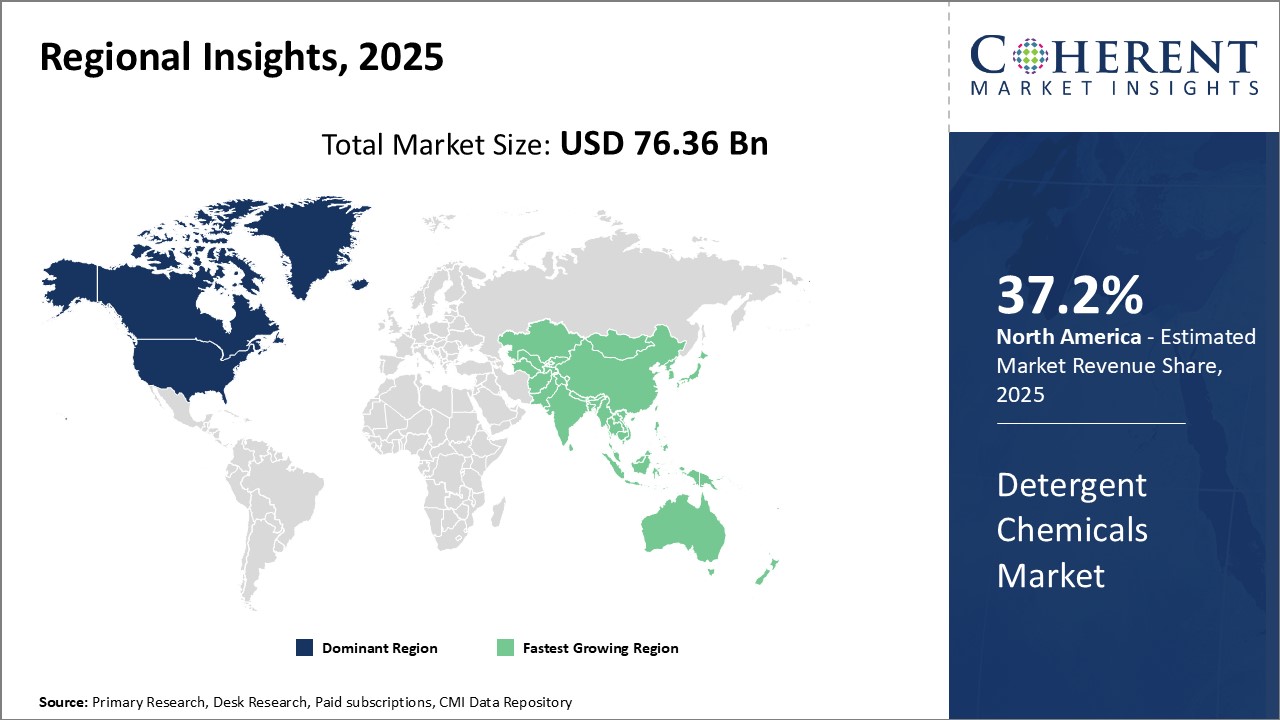
Need a Different Region or Segment? Customize now
North America has established itself as the dominant regional market for detergent chemicals and is estimated to hold 37.2% share in 2025. The region has a strong consumer base with high demand for laundry and household cleaning products. Key countries like the U.S. and Canada have well-developed retail chains that widely sell detergents across supermarkets, convenience stores, and online platforms. The region is also a hub for leading global detergent chemical manufacturers such as Procter & Gamble, Henkel and Colgate-Palmolive. These companies have established extensive production facilities and distribution networks in North America over several decades of operations. A majority of the domestic demand is met through locally manufactured products. Imports account for a small fraction of the overall market.
Asia Pacific has emerged as the fastest growing regional market for detergent chemicals in recent years. Countries such as China, India and Indonesia are witnessing rapid urbanization and rising living standards. As disposable incomes increase, more consumers are adopting laundry practices that rely on commercial detergent products. This has significantly boosted the retail sales of powders, liquids, and other formulations across Asia Pacific. The growing domestic demand in Asia’s populous nations is attracting major global players to invest in local manufacturing plants. For example, Unilever has expanded its production footprint in India to cater to the country’s surging demand. Local firms are also strengthening their presence and capturing market share through product innovation and marketing initiatives suited to Asian consumers. At the same time, Asian exports of ingredients such as surfactants and builders to detergent manufacturing hubs in North America and Europe are on the rise.
Detergent Chemicals Market Report Coverage
| Report Coverage | Details | ||
|---|---|---|---|
| Base Year: | 2024 | Market Size in 2025: | USD 76.36 Bn |
| Historical Data for: | 2020 To 2024 | Forecast Period: | 2025 To 2032 |
| Forecast Period 2025 to 2032 CAGR: | 8.9% | 2032 Value Projection: | USD 138.78 Bn |
| Geographies covered: |
|
||
| Segments covered: |
|
||
| Companies covered: |
BASF SE, The Dow Chemical Company, Huntsman International LLC, Nouryon, Croda International plc, Solvay S.A., Clariant AG, Galaxy surfactants, Vizag chemical, Mahaveer Surfactants Private Limited, Matangi Industries, Godrej Industries Limited, Ultramarine & Pigments Ltd, Narendra Surfactant & Speciality Chemicals Pvt. Ltd., Ultreze Enzymes Pvt Ltd, Infinita Biotech, and Antozyme Biotech Pvt Ltd |
||
| Growth Drivers: |
|
||
| Restraints & Challenges: |
|
||
Uncover macros and micros vetted on 75+ parameters: Get instant access to report
*Definition: The detergent chemicals market involves manufacturing and selling of various chemical compounds that are used for cleaning purposes in industries as well as households. Some key products in this market include surfactants such as anionic, non-ionic, cationic and amphoteric surfactants. Other important detergent chemicals are builders, bleaches, optical brighteners, suds suppressors, enzymes, perfumes and dyes that are formulated into powders, liquids or granules for laundry and dish care.
Share
Share
About Author
Yash Doshi is a Senior Management Consultant. He has 12+ years of experience in conducting research and handling consulting projects across verticals in APAC, EMEA, and the Americas.
He brings strong acumen in helping chemical companies navigate complex challenges and identify growth opportunities. He has deep expertise across the chemicals value chain, including commodity, specialty and fine chemicals, plastics and polymers, and petrochemicals. Yash is a sought-after speaker at industry conferences and contributes to various publications on topics related commodity, specialty and fine chemicals, plastics and polymers, and petrochemicals.
Missing comfort of reading report in your local language? Find your preferred language :
Transform your Strategy with Exclusive Trending Reports :
Frequently Asked Questions
Joining thousands of companies around the world committed to making the Excellent Business Solutions.
View All Our Clients
US Reciprocal Tax Impact Analysis On Detergent Chemicals Market
Stay updated on tariff changes with expert insights and timely information